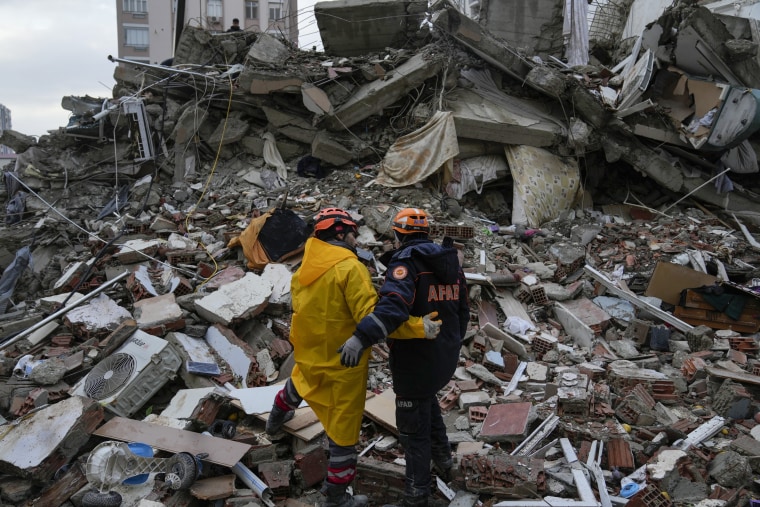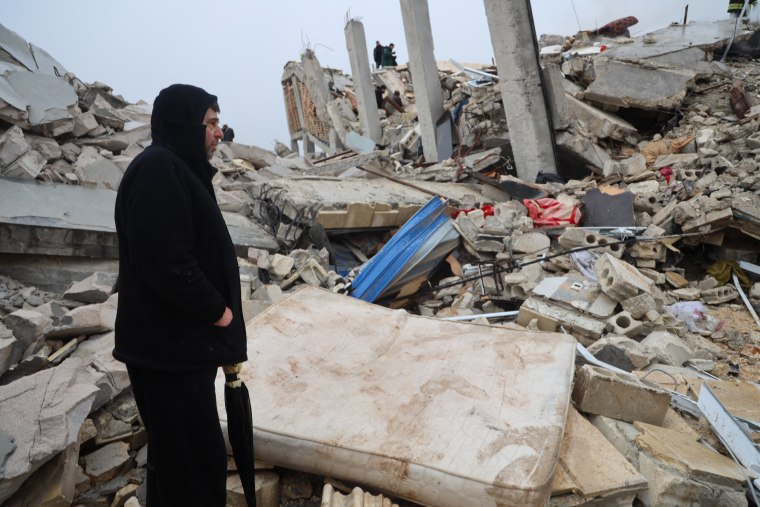The 7.5-magnitude tremor that struck Turkey on Monday after the 7.8-magnitude earthquake was an unusually strong aftershock, according to seismologists.
Aftershocks are typically about 1.2 magnitude units lower than the original quake, a statistical theory shows. The 7.5-magnitude jolt that hit Turkey at 1:24 p.m. local time, just over nine hours after the initial earthquake, was only 0.3 units smaller.
That made the force of the shock notable on its own, as well as in relation to the primary earthquake, or mainshock, experts said.
"In the most general terms, a mainshock normally has one aftershock that’s one order of magnitude lower. So, for example, on average, a magnitude-8 earthquake has one magnitude-7 aftershock," said Dara Goldberg, a geophysicist at the U.S. Geological Survey.
Many smaller aftershocks are still likely, she added.
"As we start to see how this aftershock sequence shapes up, we’ll have better estimates of how long and how productive we expect this sequence to be," Goldberg said. "But unfortunately, the reality is that there will certainly be aftershocks, and hopefully they don’t significantly hinder rescue efforts."
In magnitude measurements of earthquake size, every whole number represents a tenfold increase from the number below. Magnitude-7 earthquakes in populated areas are uncommon but devastating: In August 2021, a magnitude-7.2 quake in Haiti killed more than 2,100 people. A magnitude-5.8 aftershock followed.
Monday’s quake has killed more than 3,600 people across Turkey and Syria, with the death toll expected to rise.
Seismologists said the 7.5-magnitude shake that came after the initial quake qualified as an aftershock, not a separate earthquake, because it met aftershock classifications: It occurred within one fault line of the initial quake, and it was smaller in magnitude. What will happen next is hard to predict.
"Every earthquake sequence is different," said Gary Patterson, a geologist at the Center for Earthquake Research and Information at the University of Memphis. "The vast majority of the time, you’ll see earthquakes decreasing in power over time relative to the mainshock, and it could last days, hours, months, even years."
Turkey is prone to high seismic activity because it is near a "triple junction" where three of Earth’s tectonic plates meet.
"Wherever you have those boundaries, where two or, in this case, three plates are meeting, there’s friction along that plate boundary, which causes the Earth’s crust to bend and deform," Goldberg said. "And eventually, you get enough pressure built up that it will slide the plates past one another."
Could this quake raise the risk of more elsewhere?
Earthquakes and aftershocks this strong can happen in any place that lies on significant fault lines, including California, Alaska and other parts of the U.S. But Monday’s tremor is unlikely to trigger far-away quakes.
"People always jump to the conclusion that it’s setting off something else," said Lucy Jones, a seismologist and the chief scientist at the Dr. Lucy Jones Center for Science and Society.
In actuality, the cascade of seismic activity after an earthquake is limited in its geographic span, she said. But because of the multiple fault lines in Turkey, other areas of the country could get earthquakes.
"There’s going to be some increased risk of an earthquake," she said. "It’s pretty small. But it’s real."

There is a lot to learn from investigating Turkey’s earthquake, Patterson said, particularly when it comes to saving lives.
"A lot of engineers will be studying this earthquake to figure out how the built environment can better survive these kinds of events," he said.
Earthquakes don’t have a particular season in which they’re most likely, and climate change generally isn’t a contributing factor, experts said.
As much as everyone would like to reliably know when they will occur, earthquakes happen randomly, Goldberg said.
"We never know what’s coming, which is a challenge of seismology in general," she said.

